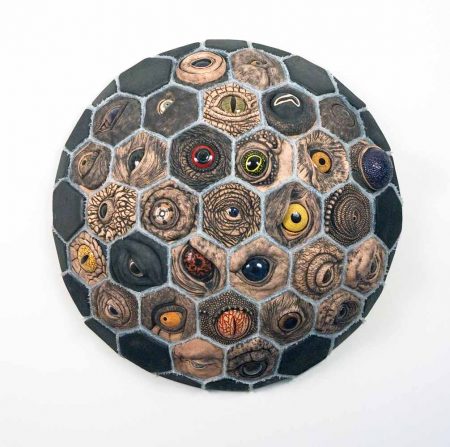
Ana England, See, 2011, glazed and unglazed low-fire earthenware, polystyrene, acrylic cement, silicone rubber, and glass beads, 28” x 28” x 11”, © Ana England.
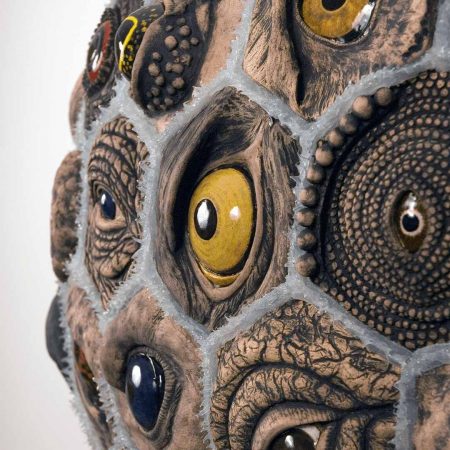
Ana England, See, 2011, glazed and unglazed low-fire earthenware, polystyrene, acrylic cement, silicone rubber, and glass beads, 28” x 28” x 11”, © Ana England.
Clay is, essentially, dirt, or, to be more poetic, earth. Many artists use clay metaphorically, including Ana England. However, she takes her material to a higher level, using it to represent the cosmos as well.

Ana England, Soil Song, 2008, porcelain, burnished and carbonized ceramic, and bronze, 30” x 58” x 7”, © Ana England.
England is an accomplished ceramist. In 1983, she earned a Master of Arts in ceramics at San Jose State University, California, and led the ceramics department at Northern Kentucky University for 30 years (she now holds the title Professor Emerita).
The title of England’s one-woman show at the Cincinnati Art Museum–“Ana England: Kinship”–plainly declares the show’s thesis as England connects galaxies to the simplest of organisms.
In her foreword to the catalog, the organizer of the exhibition, Curator of Decorative Arts & Design Amy Dehan, states that the focus is on England’s:
creations that illustrate the shared relationships, patterns, and strategies in our infinite universe. England’s continuous self-directed study of our world draws on her personal experiences and inclinations, which include memories of discourse with her father, who was a physicist; a proclivity for richly illustrated science books; gardening; travels around the globe; and living and working on the large multi-acre wooded property she shares with her artist husband (Steven Finke) in rural Felicity, Ohio.1
The artist sees the exhibition of 25 large-scale sculptures and installations covering 22 years as “a tremendous opportunity to communicate my love for the natural world to a diverse audience.” She adds, “My hope is that viewers will leave not only with a deeper appreciation of nature, but also with feelings of belonging and oneness with the world around us.”2
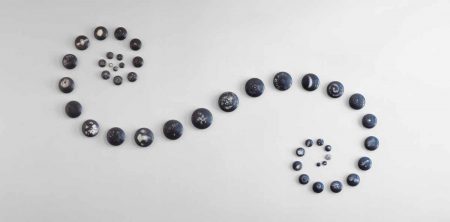
Ana England, Night Sky Spiral, 2003, burnished and carbonized ceramic with wax coating, Cincinnati Art Museum; Museum Purchase: Lawrence Archer Wachs Fund, 2003.231-qq, © Ana England.

Ana England, Night Sky Spiral, 2003, burnished and carbonized ceramic with wax coating, Cincinnati Art Museum; Museum Purchase: Lawrence Archer Wachs Fund, 2003.231-qq, © Ana England.
England respects clay and collaborates with it, letting it have its say. She is experienced enough to be able to anticipate the result, but the outcome is never assured with this material.
The alliance between England and her medium is most obvious in her raku-fired pieces where the process leaves its mark. In Night Sky Spiral II, the discs making up the wall sculpture “were pulled out of the hot kiln and then placed on top of metal or clay objects embedded in sawdust, the sawdust ignited, and the resultant flames then smothered with a lid so the objects resisted the smoke,” England explains.3 Where the clay or metal clung to the disc, it left white flecks “creating patterns that mimic astronomical sky maps.”4
Although it is possible for England to have painted—either with glaze or traditional paint–the cosmic effects, the fact that those markings are due to the raku firing, bring it closer to the oneness of nature.
In Night Sky Spiral II, England arranged 43 ceramic discs, waxed to impart a “soft, luminous sheen,”5 in a double spiral. She connected them with a graceful curve. Starting on the left, the pieces, which resemble river rocks polished by the current, unspool and grow in size. On the right, they diminish in size and roll up into another gentle spiral. Spirals are ubiquitous in nature and are described by the Fibonacci series of numbers,6 and a double spiral suggests “spinning–the fundamental energy.”7
Given that, I venture to offer a very mundane view. The discs bear a striking resemblance to Frisbees, and, like actual Frisbees, they float through the air and spiral to elude anyone hoping to snag one.

Ana England, Drift, 2016, glazed earthenware, 73 x 120” x 5” Photography by Tony Walsh, © Ana England.
In Drift, England turns from the vastness of the heavens, to the microscopic: single-celled radiolaria. Carried along on the oceans’ currents, the radiolaria have glass-like exoskeletons, which are based on radial, hexagonal, and pentagonal shapes, each one as unique as a snowflake or fingerprint. England glazed the surfaces to approximate the appearance of these delicate creatures
Like in Night Sky Spiral II, England has arranged the doily-like discs across the wall in a roughly spiraling progression, allowing for the will of the currents.
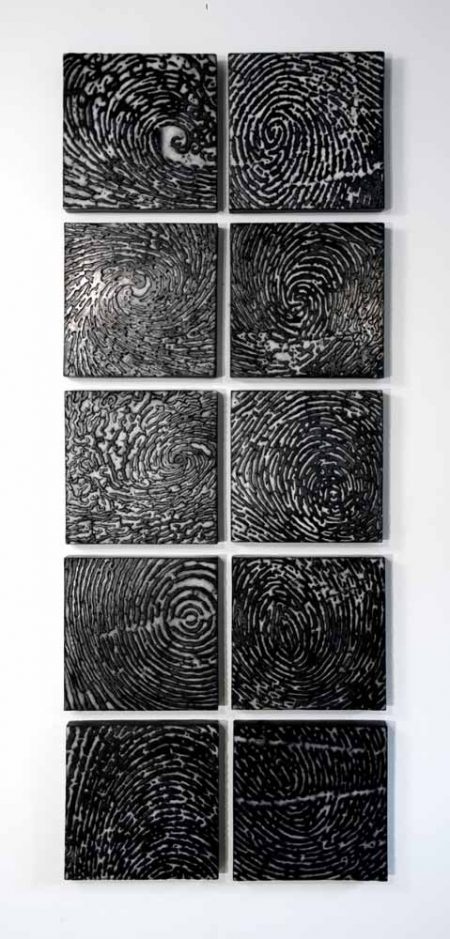
Ana England, Shared Identity II, 2016, carved and carbonized ceramic, 60 ½” x 23 ½”, x 1 ¾”, © Ana England.
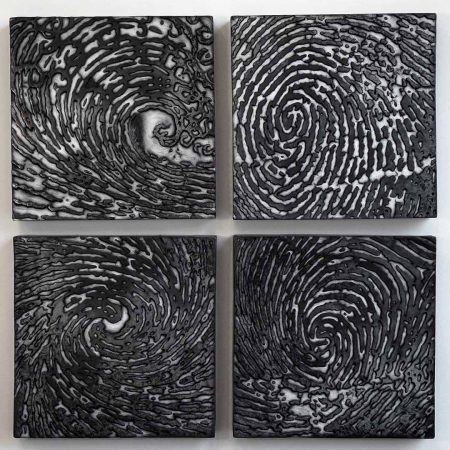
Ana England, Shared Identity II, 2016, carved and carbonized ceramic, 60 ½” x 23 ½”, x 1 ¾”, © Ana England.
In Shared Identity II, England emphasizes the continuum of human life and the world. There are two vertical rows of paired squares of the same size. Each one features whorls and concentric circles carved into the surface and carbonized to contrast with a white ground, as in Night Sky Spiral II. In the right row are fingerprints, and on the left are representations of a wave, a galaxy, a hurricane, growth rings, and a magnetic field—all natural occurrences. The artist has linked the most personal and intimate to the universe.
Dehan sums up England’s body of work in the catalog foreword:
. . . her finished works not only delight the eye, but encourage dialogue and contemplation about who we are, how we relate to the greater cosmos, and how we interact and connect with one another.9
–Karen S. Chambers
“Ana England: Kinship,” through March 4, 2018. Cincinnati Art Museum, Eden Park, 953 Eden Park Dr., Cincinnati, OH 45202, 513-721-ARTS (2787), cincinnatiartmuseum.org. Hours: Tues.-Sun., 11 a.m.-5 p.m., Thurs., 11 a.m.-8 p.m.
Endnotes:
1 Dehan, Amy. “Ana England: Kinship,” Ana England: Kinship, Cincinnati, Cincinnati Art Museum, 2017, p. 1.
2 “Ana England: Kinship,” press release.
3 Bloomfield, Maureen. “The Path of the Sphere,” Ana England: Kinship, Cincinnati, Cincinnati Art Museum, p. 2.
4 Night Sky Spiral II, “Ana England: Kinship,” Cincinnati Art Museum gallery label.
5 Ibid.
6 “The Fibonacci numbers are Nature’s numbering system. They appear everywhere in Nature, from the leaf arrangement in plants, to the pattern of the florets of a flower, the bracts of a pinecone, or the scales of a pineapple. The Fibonacci numbers are therefore applicable to the growth of every living thing, including a single cell, a grain of wheat, a hive of bees, and even all of mankind.” Parveen, Nikhat, UGA. “Fibonacci in Nature,” University of Georgia,jwilson.coe.uga.edu/EMAT6680/Parveen/Fib_nature.htm.
7 Night Sky Spiral II, “Ana England: Kinship,” Cincinnati Art Museum wall label.




